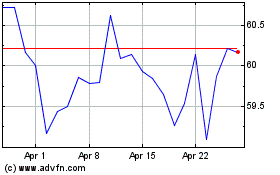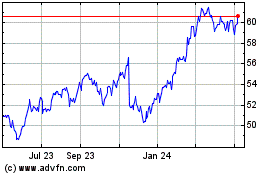Amazon Widens War With Walmart for Low-Income Shoppers
March 07 2018 - 9:29AM
Dow Jones News
By Laura Stevens
Amazon.com Inc. is expanding its discounted Prime program, its
latest salvo in a battle with Walmart Inc. for low-income
shoppers.
The online retail giant said Wednesday that it will extend its
$5.99 monthly Prime membership to the roughly 20% of the U.S.
population that is signed up for Medicaid. Last year, the company
introduced the discount--Prime membership ordinarily costs $12.99 a
month or $99 a year--by offering it to people who obtain government
assistance with cards typically used for the food-stamp program,
formally called the Supplemental Nutrition Assistance Program.
Prime perks include unlimited two-day shipping and video and
music streaming.
Amazon's pursuit of more low-income shoppers comes as analysts
estimate Prime membership has reached more than half of all U.S.
households with internet and largely saturated the wealthier
segment.
Even as shopping increasingly shifts online, many low-income
customers continue to frequent brick-and-mortar stores, where they
can pay with cash or a SNAP card. Walmart has more than 4,600
stores in the U.S. and Dollar General Corp.--which targets
households earning $40,000 or less--has more than 14,000, many in
low-income, rural areas.
Walmart, the country's largest retailer by revenue, is seeking
to attract wealthier shoppers, ramping up efforts to better compete
with Amazon online. It is wooing premium brands to walmart.com;
late last year it announced plans to start selling products from
department store Lord & Taylor online. And last week it
replaced many of its private-label clothing brands with new,
slightly more expensive and fashion-forward versions.
Amazon's discounted membership, which is limited to four years
of eligibility, is increasing orders for items like baby food, toys
and diapers, said Aaron Perrine, who leads the program. Customers
are also using the company's one- and two-hour shipping option,
Prime Now.
"They come for shipping," he said. "They stay for
digital"--specifically Amazon's video- and music-streaming
options.
These customers also frequently purchase the company's own
devices, including its Fire TV streaming sticks, Echo Dot speakers
and Fire tablets, he added.
Lower-income consumers have been the fastest-growing segment of
online shoppers, analysts say, but still face potential
impediments. They may lack internet access, banking resources like
credit cards--SNAP cards can't be used to pay online--and safe
places to deliver a package.
But consumer habits are shifting rapidly. Most low-income
shoppers now have a mobile phone, and companies including United
Parcel Service Inc. and Amazon have been adding lockers and other
pickup locations to allow for safe delivery. The retailer has also
recently expanded the ability to reload account balances with cash
at convenience stores and other locations.
Sarah Nassauer contributed to this article.
Write to Laura Stevens at laura.stevens@wsj.com
(END) Dow Jones Newswires
March 07, 2018 09:14 ET (14:14 GMT)
Copyright (c) 2018 Dow Jones & Company, Inc.
Walmart (NYSE:WMT)
Historical Stock Chart
From Mar 2024 to Apr 2024

Walmart (NYSE:WMT)
Historical Stock Chart
From Apr 2023 to Apr 2024
